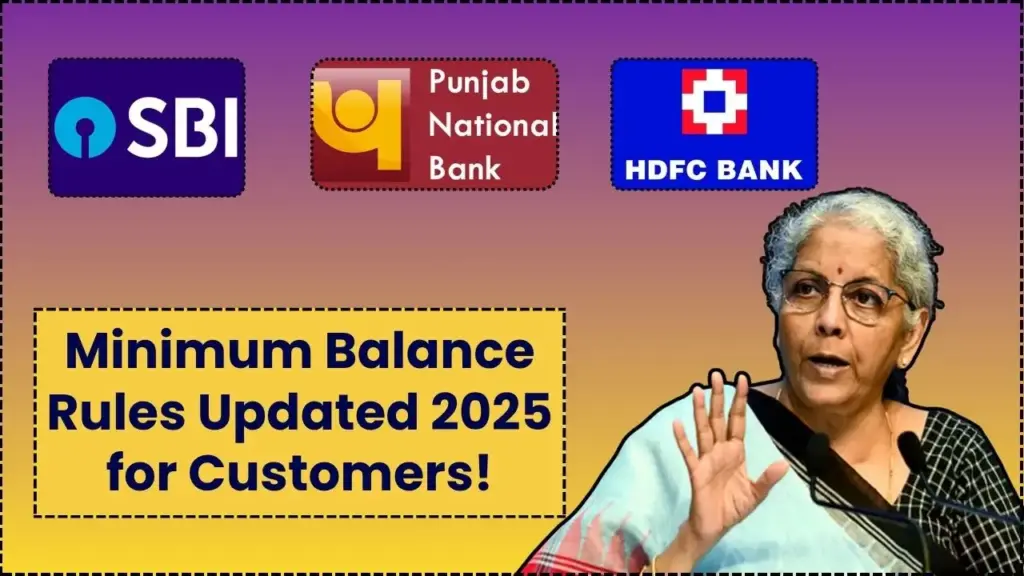If you’re confused about where the minimum balance rules stand right now, you’re not alone. Over the past year, banks have tweaked policies to make savings accounts easier to maintain especially at large public sector banks. The headline change: SBI and PNB have removed penalties tied to minimum balance shortfalls on savings accounts, while HDFC Bank still follows a branch-category-based average balance system with a capped shortfall fee. For most customers, that translates to simpler choices: go fully zero-penalty with SBI/PNB, or meet HDFC’s AMB/AQB or use the FD alternative.

Minimum balance limits for savings accounts matter because they directly affect your monthly cash flow, fee risk, and overall banking experience. This guide focuses on what actually applies today: zero-penalty policies at SBI and PNB, and the specific AMB/AQB thresholds and fee caps at HDFC Bank. You’ll also find the FD workaround many HDFC customers use to stay compliant without parking large idle amounts in savings, plus quick definitions so you can calculate AMB/AQB correctly.
Minimum Balance Limits Set
| Bank | Requirement | Metro/Urban | Semi-Urban | Rural | Notes |
|---|---|---|---|---|---|
| SBI | No minimum balance penalty | None | None | None | Regular savings have no non-maintenance penalty; BSBDA is zero-balance. |
| PNB | No penalty for non-maintenance | None | None | None | Effective July 1, 2025, across savings variants as per official communication. |
| HDFC Bank | AMB/AQB applies on regular savings | ₹10,000 AMB or ₹1 lakh FD (≥1 year 1 day) | ₹5,000 AMB or ₹50,000 FD (≥1 year 1 day) | ₹2,500 AQB or ₹25,000 FD (≥1 year 1 day) | Shortfall fee 6% of deficit or ₹600, whichever is lower; salary/BSBDA are zero-balance. |
HDFC Bank Minimum Average Balance Criteria
For regular savings, HDFC Bank requires a minimum average monthly balance of ₹10,000 in urban branches, ₹5,000 in semi-urban, and an average quarterly balance of ₹2,500 in rural branches. Don’t want to maintain the average in the savings ledger? Park a fixed deposit as a substitute: ₹1 lakh (urban), ₹50,000 (semi-urban), or ₹25,000 (rural), each for at least 1 year 1 day. If there’s a shortfall, the fee is 6% of the deficit or ₹600, whichever is lower. Eligible salary accounts and BSBDA-type accounts remain zero-balance.
SBI And Other Public Sector Banks
SBI continues with its customer-friendly stance: no penalties for not maintaining minimum balance in regular savings accounts. If you want a straightforward, low-friction setup, SBI’s regular savings and BSBDA options make sense for most households, students, pensioners, and anyone who doesn’t want to track monthly averages. Several public sector peers have trended in the same direction, making day-to-day banking simpler and cheaper for retail customers.
PNB Waives Minimum Balance Charge
From July 1, 2025, PNB no longer charges penalties for non-maintenance of minimum average balance on savings accounts. The policy supports financial inclusion and reduces the burden on customers who keep variable balances—like small business owners, gig workers, and rural families. The communication was made publicly and aligns PNB with the broader zero-penalty approach seen at SBI.
Average Monthly Balance Explained
Average Monthly Balance (AMB) is the arithmetic mean of daily closing balances across a calendar month. If you dip below the required numbers for several days especially late in the month your monthly average can fall and trigger a shortfall. Average Quarterly Balance (AQB) works the same way but over a quarter. This is why many HDFC customers either smooth their balances across the month or use the FD alternative to avoid surprises.
How To Avoid Penalties At HDFC Bank
- Maintain the right average: ₹10,000 (urban), ₹5,000 (semi-urban), ₹2,500 AQB (rural).
- Use the FD alternative: ₹1 lakh (urban), ₹50,000 (semi-urban), ₹25,000 (rural) for at least 1 year 1 day.
- Choose a zero-balance product if eligible: salary accounts or BSBDA remove AMB/AQB requirements.
- Track balances weekly: set alerts near billing cycles and month-end.
- Consolidate accounts: fewer active accounts makes average-balancing easier.
What This Means for You In 2025
If you want zero-penalty simplicity, SBI and PNB are the most convenient choices across regular savings. If you prefer HDFC Bank’s network or ecosystem, plan your AMB/AQB or use the FD method to stay compliant without locking up too much in the savings ledger. For families with multiple accounts, mixing a zero-balance account (for spending) with a higher-feature regular account (for services) can provide the best of both worlds.
Is There a Catch on Zero-Balance Talk?
Zero-balance accounts such as BSBDA often come with lighter features: limited free transactions, basic cheque book issuance, or caps on certain services. If you need premium features or higher free transaction limits, a regular savings account may still be a better fit even if it means maintaining AMB or booking a small FD to qualify for waivers.
Actionable Checklist
- Prefer no monitoring? Open or switch to SBI/PNB savings for a zero-penalty setup.
- Staying with HDFC? Decide between maintaining AMB/AQB or booking the FD alternative.
- Confirm your branch category: urban, semi-urban, or rural impacts the thresholds.
- Set SMS/app alerts for balance dips and month-end snapshots.
- Reassess annually: product features, fee caps, and offers can change.
For everyday customers, the smartest move right now is to align your account choice with how you actually use your money. If you want a no-stress setup without tracking averages, SBI and PNB clearly lead with no penalties for not maintaining minimum balance on regular savings. If you bank with HDFC for its services and network, you can stay fee-free by either maintaining the branch-wise AMB/AQB or by using the fixed deposit alternative, which many customers prefer to avoid constant balance monitoring. In short: pick zero-penalty simplicity with SBI/PNB or use HDFC’s clear compliance routes to keep full features without incurring charges.
SBI Fixed Deposit 2025: Top Monthly Income Plans with the Best Market Returns
FAQs on Minimum Balance Limits Set
Does SBI require a minimum average balance now?
SBI does not levy penalties on non-maintenance of minimum balance for regular savings; BSBDA remains a true zero-balance option for basic banking.
From when did PNB remove minimum balance penalties?
PNB’s waiver on penalties for non-maintenance in savings accounts is effective July 1, 2025, per the bank’s official communication.
What’s the HDFC Bank penalty if AMB isn’t met?
For regular savings accounts where AMB/AQB applies, HDFC charges 6% of the shortfall or ₹600, whichever is lower, subject to variant applicability.
Can an FD replace AMB at HDFC?
Yes. An FD of ₹1 lakh (urban), ₹50,000 (semi-urban), or ₹25,000 (rural) with a minimum tenure of 1 year 1 day can be used as an alternative to maintaining the average balance.
















